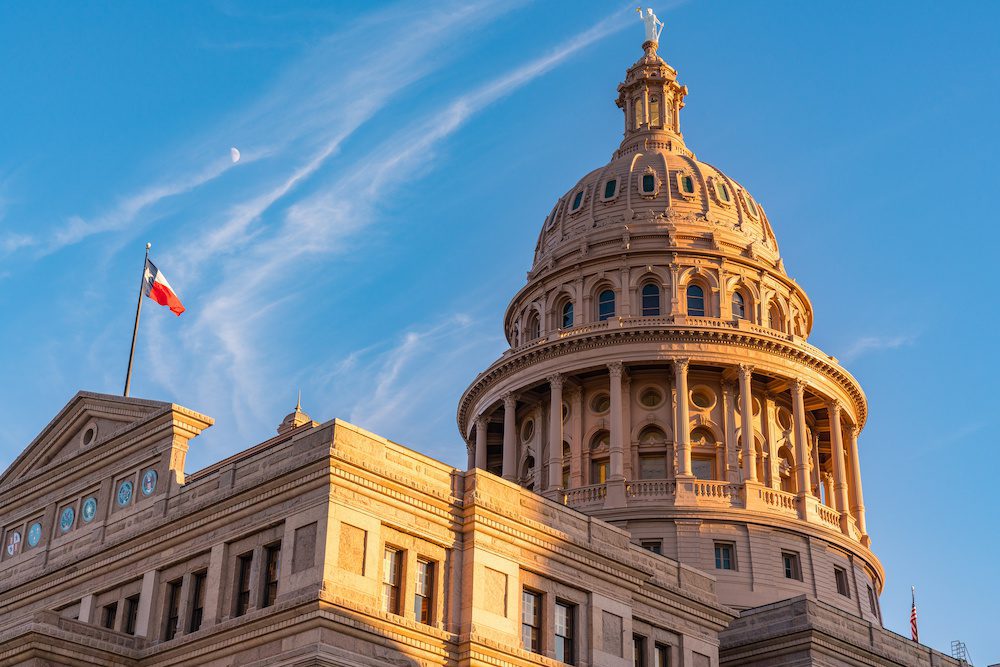
Texas State Capitol Building in Austin, Texas
Did you know that Texas built the seventh-largest building in the world (at the time) with no money down? This tale is the quintessential Texas story of how the deal went down with big hats, big egos, no cash, and no cattle.
Texas Goes Big
When the Republic of Texas joined the United States in 1846, Texas, the only state that was a nation first, retained all public lands under the statehood agreement. In 1875, Texas had a generous homestead policy that enabled ranchers to secure massive holdings. It also had little cash but wanted to build a big, bodacious capitol building 11 feet taller than the nation’s capitol.
The legislature made a deal with Charles B. and John V. Farwell of Chicago to trade three million acres in the Panhandle Permian Basin for building the capitol. Cattle was the investment bubble of the day, and money-making ranches appealed to investors from Chicago, which was the center of the meat-packing industry.
Building the Capitol
Mathias Schnell of Rock Island, Florida, was the first to post a $250,000 bond to build the capitol in January 1882. Elijah E. Meyers of Detroit drew up the plans for $12,000, and by May, Schnell had assigned his interest to Taylor, Babcock, and Company. John V. Farwell was a principal and company representative. The project became more urgent because the original capitol burned during the design process.
The estimate for construction on the new capitol was $3.2 million in materials and labor, but costs began to escalate. At the same time, watered land was going for $.55 an acre and unwatered land for $.25 per acre. The poor land value made the trade less attractive to Taylor Babcock and amounted to overpayment for the land.
The original plan was to build the capitol out of limestone, but when it arrived, it was discolored. Replacing it extended the completion date and increased costs as Taylor Babcock carted granite from Marble Falls to the Austin-bound train.
As costs escalated, the State of Texas supplied prison labor, and Taylor Babcock housed the prisoners. The local union objected, and Taylor Babcock brought in 64 Scottish stonecutters. The Labor Board fined Taylor Babcock $64,000 for using illegal immigrant labor. Four years of appeals later, the Labor Board reduced the amount to $8,000. Construction resumed in 1885.
Meanwhile, Back at the Ranch
It takes capital to start a ranch, build houses and barns, purchase stock, and provide water. Babcock planned to buy 150,000 head of cattle at $20 per head. He expected an investment of $3 million to yield 30% or $1 million annually, less drought costs. Degradation of the herd would require $2 million.
Taylor Babcock began running out of money as they worked on the capitol and started the ranch. They had initially committed to $5 million to build the capitol, likely raised from the Chicago syndicate. But the company still needed to build the ranch.
John V. Farwell created the Capitol Freehold Land and Investment Company, Ltd. in London to raise money. The enterprise sold debentures yielding 5% interest. Farwell planned to raise $15 million and successfully raised $10 million. He issued bonds at 7% interest for the rest.
A trail driver named Ab Blocker created the ranch’s XIT brand.
A Win for Texas
The capitol building in Austin opened to the public on San Jacinto Day, April 21, 1888. It is the largest state capitol building in the country. The total expense to build it was $3,744,630.60, and the syndicate paid $3,224.593.45.
The cattle market crashed in 1886 and 1887, and the ranch couldn’t sell its cattle, causing it to operate without showing a profit. In 1901, the syndicate began selling land to pay off the bonds and continued until 1909, when they paid off the last of them and The Capitol Freehold Land and Investment Company, Ltd. dissolved. XIT sold the last of its cattle in November 1912.
Investment Lessons
In the McGowan Offices at the Crescent, you can see a 1917 Capitol Freehold Land and Investment Company certificate traded on the London Stock Exchange. The equity did better than the 7% on the bonds, and both did better than holding cash during the same period.



